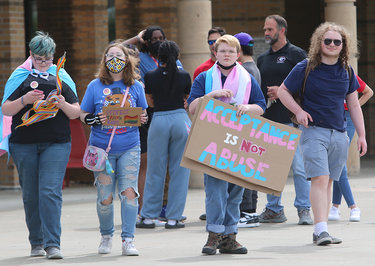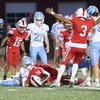Hearing on GCSD Code of Conduct: ‘An opportunity for people to weigh in’
Enterprise file photo — Michael Koff
At Guilderland’s anti-hate rally this year, some students said they were criticized for the way they dressed or the way they wore their hair. Changes to the district’s dress code are “mindful of how diversity plays out in our school district,” said Superintendent Marie Wiles.
GUILDERLAND — On July 5, residents of the Guilderland school district and members of the school community will have a chance to comment on the district’s updated code of conduct for students.
The district has spent a good portion of the past school year updating its code, Superintendent Marie Wiles told The Enterprise this week.
“It’s really just an opportunity for people to weigh in on the document,” she said of the July 5 hearing.
The hearing will be held as part of the board’s annual reorganizational meeting in which members are sworn in, a president and vice president are elected, and designations — such as committee assignments and the district’s banks and newspapers — are made.
The in-person meeting, held in the large-group instruction room at Guilderland High School, at 8 School Road, starts at 7 p.m. It will also be live-streamed.
State Education Law requires a public hearing “that provides for the participation of school personnel, parents, students and any other interested parties” before a code is adopted by the school board.
Explaining why Guilderland has a code, the document says, “Students need to be supported and engaged in school in order to promote strong character and appropriate conduct. It is also essential that students are able to take age-appropriate responsibility for their own behavior.”
The Guilderland code says, “Student discipline and support policies and practices will be implemented in a manner which is caring and equitable, respectful and based on trust among administration, staff, students, and families and holds all individuals accountable, but is restorative and solutions oriented, rather than punitive.”
This is to help students learn from their mistakes and understand why their behavior was unacceptable as well as acknowledging harm and understanding how they could have done differently. Students, the code says, are to take responsibility for their actions, learn skills to do better, and understand there will be consequences if their unacceptable behavior persists.
Dress code
Wiles said a portion of the code that had “quite a few changes” was on the school’s dress code.
“We’re trying to be much more explicit about what’s appropriate, what’s not appropriate, being mindful of how diversity plays out in our school district,” she said.
Wiles also said the “differences between rules for young ladies and young men” were carefully examined.
The dress code says that, while students and their parents have “the primary responsibility” for acceptable appearance, teachers should “exemplify and reinforce acceptable student dress.”
A seven-item list says that a student’s dress, grooming, hair style, jewelry, make-up, and nails must be unlikely to injure people or damage property … and “not substantially disrupt or materially interfere with the educational process.”
“Extremely brief” and see-through garments are not appropriate and underwear is to be covered by outer clothing. A student’s face is not to be covered “except for a medical or religious purpose.”
Items that are “vulgar, obscene, libelous, or denigrate, harass, or discriminate against others on account of race (including traits historically associated with race, such as hair texture and protective hairstyles like braids, locks, and twists), color, weight, religion, religious practice, disability/ability, creed, national origin, ethnic group, gender (including gender identity and expression), sex, sexual orientation disability/ability, or socio-economic status” are not allowed.
Finally, the code says, dress cannot promote or endorse the use of alcohol, tobacco nicotine products, marijuana or controlled substances or illegal drugs, or encourage other illegal or violent activities.
The code goes on to stress, “Nothing in this policy will be construed to limit the ability of students to express their gender identity through clothing, jewelry, makeup, or nail color or styles, or to discipline students for doing so.
“Likewise, nothing in this policy will be construed to restrict students from wearing hairstyles as a trait historically associated with race (such as but not limited to hair texture and protective hairstyles like braids, locks, and twists) or to discipline them for doing so.”
Staff members are to address dress code violations with students privately to “determine if there are factors impacting the student’s ability to meet the dress code, and help address these issues.”
Further, the policy states, “Students whose appearance violates the student dress code are required to modify their appearance by covering or removing the offending item, and if necessary or practical, replacing it with an acceptable item. Any student who refuses to do so will be subject to discipline, up to and including in-school suspension for the day.”
Prohibited conduct
Students are to be civil, the code says, and show “proper regard for the rights and welfare of other students, district personnel and other members of the school community, and for the care of school facilities and equipment with the goal of making school a community free of violence, intimidation, bullying, harassment, and discrimination.”
The policy says, “The best discipline is self-imposed.”
Prohibited actions apply to school buses as well as school buildings and grounds.
Actions that constitute “disorderly conduct” include running in hallways; making unreasonable noise; using language or gestures that are profane, lewd, vulgar or abusive; obstructing traffic; trespassing; and misusing computers or electronic communication.
Insubordination is described as failing to comply with “reasonable directions” from staff or being late for or missing or leaving school without permission, including skipping detention.
Students are not to “engage in conduct that prevents others from being able to learn, focus, or be engaged in their work,” including “inappropriate sexual contact.”
Further, students are not to be violent, which includes “hitting, kicking, punching, and scratching” nor are they to possess a weapon.
The policy provides a long list of examples of “conduct that endangers the safety, physical or mental health or welfare of others,” including stealing, bullying, hazing, smoking, drinking alcohol, using drugs, gambling, exposing “private parts of the body,” using vulgar language, setting off false alarms, and “knowingly submitting false information to school staff.”
Forms of academic misbehavior include plagiarism, cheating, copying, altering records, and “assisting another student in any of the above actions.”
Finally, the code addresses off-campus behavior that would “substantially disrupt the educational process in the school or a school function,” including cyberbullying.
Corporal punishment
The code prohibits corporal punishment, defined as “any act of physical force upon a student for the purpose of punishing that student.”
However, it says that “reasonable physical force” can be used to “protect oneself, another student, teacher or any person from physical injury”; to protect property; or to “restrain or remove a student whose behavior interferes with the orderly exercise and performance of school district functions, powers and duties, if that student has refused to refrain from further disruptive acts.”
The district is to file all complaints about the use of corporal punishment with the state’s commissioner of education in accordance with commissioner’s regulations.



